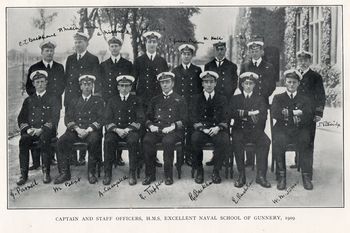Patrick Macnamara
Rear-Admiral SIR Patrick Macnamara, K.B.E., C.B., Royal Navy (11 January, 1886 – 4 April, 1957) was an officer of the Royal Navy.
Life & Career
Patrick Macnamara was born on 11 January, 1886, the son of Charles Macnamara. He was educated at Bradfield College, and entered the Royal Navy via the training ship Britannia in January, 1901. He was awarded the King's Medal for his term. As a Midshipman he served in the battleships Majestic and Duncan.
He was appointed as Sub-Lieutenant in Command of the first-class torpedo boat T.B. 025 on 27 November, 1906.[1] Barely two months later on 25 January, 1907, he transferred to the Hibernia.[2]
In his examinations for the rank of Lieutenant he took five First Class certificates, and on 21 May, 1907, while serving in the Hibernia, he was promoted to the rank of Lieutenant with seniority dated 30 October, 1906.[3] He was appointed to H.M.S. Excellent on 27 July, 1908, to qualify for gunnery duties, on the course beginning on 24 August.[4]
He was thanked in 1908 for his invention for directing gunfire. In 1913, he was again thanked for his work in creating a "Method for plotting Rangefinders", this last no doubt being Macnamara's Plotter, a nice refinement for the new Dreyer Fire Control Tables, but one which proved unworkable given the period.[5]
Great War
On 3 August, 1914, Macnamara was appointed to H.M.S. King Edward VII for War Staff Duties on the staff of Vice-Admiral Edward E. Bradford, Vice-Admiral Commanding the Third Battle Squadron.[6] He was appointed Gunnery Officer of H.M.S. Tiger on 9 March, 1915.[7]
On 30 June, 1918, Macnamara was promoted to the rank of Commander,[8] and replaced as Gunnery Officer on 31 August, remaining in Tiger as Executive Officer.[9][10]
Post-War
Macnamara was promoted to the rank of Captain on 30 June, 1925.[11]
In October 1927, he assumed command of the cruiser Effingham.
On 1 January, 1938, he was appointed a Commander of the Military Division of the Most Excellent Order of the British Empire (C.B.E.).[12] On 11 July, 1940, he was appointed an Additional Member of the Third Class, or Companion, of the Military Division of the Most Honourable Order of the Bath (C.B.).[13]
On 1 September, 1940, he was appointed as Rear Admiral, Scapa. On 3 October, this was augmented by the additional appointment as Admiral Superintendent, Lyness. On 1 May, 1942, he was appointed as Admiral Superintendent, Orkneys. He was finally reverted to the Retired list on 28 May, 1946.[14]
Gunnery
He invented several fire control aids, such as a time-of-flight watch around 1909 to help spotters know when to expect to see their shells fall, deployed perhaps by 1911,[15] and was trying to effect a pneumatic plotter so Mark IV Dreyer tables could automatically plot range cuts signaled from multiple sources, although on 6 July 1914 this ambitious design was rejected in favour of the humble Brownrigg Keyboard.[16]
See Also
- Service Records
- Brooks, John (2005). Dreadnought Gunnery and the Battle of Jutland: The Question of Fire Control. Oxon: Routledge. ISBN 0714657026. (on Amazon.com and Amazon.co.uk).
- "Rear-Admiral Macnamara" (Obituaries). The Times. Monday, 8 April, 1957. Issue 53810, col A, pg. 14.
| Naval Appointments | ||
| Preceded by George Pilkington |
Captain of H.M. T.B. 25 27 Nov, 1906[17][18] – 25 Jan, 1907[19] |
Succeeded by George A. Saltren-Willett |
| Preceded by Roger M. Bellairs |
Captain of H.M.S. Effingham 18 Oct, 1927[20] – 13 Oct, 1929[21] |
Succeeded by Bruce A. Fraser |
| Preceded by James S. M. Ritchie |
Royal Navy Naval Attaché at Washington, D.C. Mar, 1931[22] – May, 1933[23] |
Succeeded by Alan R. Dewar |
| Preceded by Alban T. B. Curteis |
Captain of H.M.S. Nelson 14 Sep, 1933[24] – 21 May, 1934[25] |
Succeeded by Algernon U. Willis |
Footnotes
- ↑ The Navy List. (January, 1907). p. 399.
- ↑ "Naval and Military Intelligence". The Times. Saturday, 26 January, 1907. Issue 38240, col C, p. 11.
- ↑ The London Gazette: no. 28024. p. 3593. 24 May, 1907.
- ↑ The Navy List. (October, 1908). p. 312.
- ↑ Macnamara Service Record. The National Archives. ADM 196/50/130. f. 238.
- ↑ The Navy List. (December, 1914). p. 343.
- ↑ The Navy List. (October, 1915). p. 398q.
- ↑ The Navy List. (December, 1918). p. 122.
- ↑ Macnamara Service Record. The National Archives. ADM 196/50/130. f. 238.
- ↑ The Navy List. (December, 1918). p. 920.
- ↑ The London Gazette: no. 33063. p. 4452. 3 July, 1925.
- ↑ The London Gazette: (Supplement) no. 34469. p. 7. 1 January, 1938.
- ↑ The London Gazette: (Supplement) no. 34893. p. 4243. 11 July, 1940.
- ↑ Macnamara Service Record. The National Archives. ADM 196/50/130. f. 257.
- ↑ Brooks. pp. 56, 63.
- ↑ Brooks. Dreadnought Gunnery. p. 171.
- ↑ Macnamara Service Record. The National Archives. ADM 196/50/130. f. 238.
- ↑ The Navy List. (January, 1907). p. 399.
- ↑ Macnamara Service Record. The National Archives. ADM 196/50/130. f. 238.
- ↑ The Navy List. (February, 1929). p. 234.
- ↑ Macnamara Service Record. The National Archives. ADM 196/50/130. f. 238.
- ↑ Mackie, Colin. ROYAL NAVY SENIOR APPOINTMENTS.
- ↑ Mackie, Colin. ROYAL NAVY SENIOR APPOINTMENTS.
- ↑ Macnamara Service Record. The National Archives. ADM 196/50/130. f. 238.
- ↑ Macnamara Service Record. The National Archives. ADM 196/50/130. f. 238.
